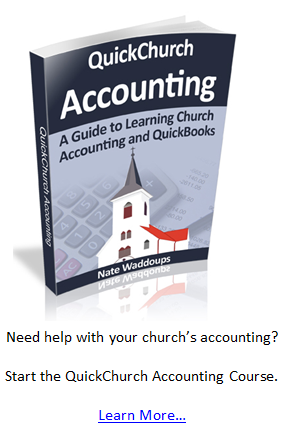In the last lesson we talked about how to make the proper journal entries for revenues and expenses. In this lesson you’ll learn that revenues and expenses are actually temporary accounts that require a journal entry to be closed out at the end of every year.
*Note: Most accounting software programs will perform all the closing journal entries for you. I still recommend you read this lesson so you know what the accounting software is doing. I especially recommend you read the section entitled Net Assets (Keeper of Net Income).
Temporary Accounts
Let’s talk a little bit more about these temporary revenue and expense accounts. The statement of activities (we talked about this statement in Lesson 2 “Catching the Vision”) that your church generates at the end of the year will have all the revenues and expenses listed for the year. Each year this statement starts over. This means that each year your revenues and expenses start back over at zero (a clean slate, if you will).
This is very different than the statement of financial position (also discussed in Lesson 2) generated at the end of each year. This statement of financial position contains running balances that are never reset. For example, if your church bought land 25 years ago for $50,000, this will still be reflected on the statement of financial position. If your church bought $25,000 of land this year, then the $25,000 would be added to the $50,000 on the statement of financial position.
In order to start over every year, all revenues and expenses are closed out. Let me show you how this is done.
Example of Closing Out Revenues and Expenses
Let’s pretend that your church had $100,000 worth of contribution revenue and $50,000 worth of expenses for the year. Here’s what the closing journal entry would look like.

When you decrease a revenue account you debit the account (according to the rules we learned in the last few lessons). Because we are closing out the account, we are in essence getting rid of all revenues for the year (so we debit them – opposite of what we did with them all year). We’ll debit Contribution Revenue for $100,000.
When we get rid of an expense we credit the account (again, this comes from the rules we learned earlier). We’ll credit expenses for $50,000.
This leaves a difference of $50,000. That difference is your church’s net income for the year. Makes sense right? Revenues minus expenses equals net income.
Net Assets (Keeper of Net Income)
Finally, we get to an example of a journal transaction with net assets. When your church has more revenues (incoming cash) than expenses (outgoing cash) for the year, then your church’s net income has increased. When your church has more expenses (outgoing cash) than revenues (incoming cash) your church’s net income has decreased.
Eventually the net income account is also closed out (because it’s on the Statement of Activities, it’s a temporary account that must be closed). Let’s take a look at the journal transaction that closes out net income.

The net income account is closed out and set back to zero, but not to worry - the information is safely stored in an account called Net Assets. This also keeps our accounting equation (Assets = Liabilities + Net Assets) in perfect balance.
More on Net Assets
Hopefully the example above helps you understand a little bit more about the nature of net assets Here’s an accounting equation that might help clarify.
Net Assets at the beginning of the year + Net Income for the year = Net Assets at the end of the year.
Or, stated a bit differently:
Net assets at the beginning of the year + All Revenues for the year – All Expenses for the year = Net assets at the end of the year.
Stated in words, the net asset account is made up of all the net income your church has generated over the years. Let’s take a look at an example of what I’m talking about.
In the first year of its existence, 1st Church starts out with zero net assets. However, during the first year 1st Church receives $50,000 worth of contributions and only spends $20,000 for expenses. The net income or “profit” for the year was $30,000. This means at the end of year 1 the balance in Net Assets for 1st Church is $30,000.
In the second year 1st Church has a net income of $30,000. In the third year 1st Church actually has a net loss of $40,000 (it spent more than it made that year). This is all reflected in the net asset account (pictured below).

The net assets account is made up of all the income your church has generated over the years.
Conclusion
Today we learned about closing out our revenue and expense accounts. We also learned that the statement of activities is reset to zero every year. Finally, we learned that the net asset account keeps track of all the income the church generates over the years. In the next section we’ll learn about ledgers (the next phase in the church accounting cycle).
Side Note: It’s probably worth mentioning that church accounting software will close these accounts out for you. I still think you should know what the accounting software is doing, but if you have software, then you won’t have to close out revenues and expenses to net assets at the end of the year because the software does it for you automatically.

